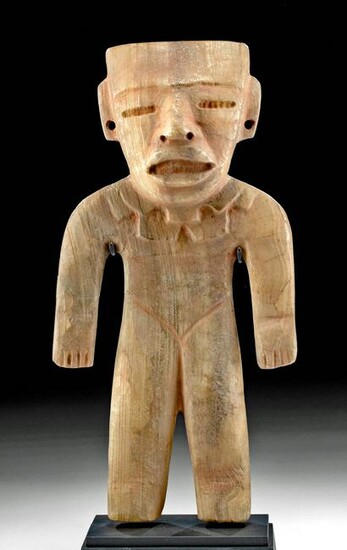Massive Teotihuacan Tecali Stone Figure w/ Red Cinnabar
Pre-Columbian, Valley of Mexico, Teotihuacan, ca. 3rd to 7th century CE. An enormous example of a stylized figure standing atop delineated legs, hand-carved from a stone type known as tecali. Tecali is traditionally known as "Mexican onyx," however it is not part of the agate family; it is closer to a calcite stone like banded alabaster. This intriguing effigy presents nude with an incised V-shaped groove separating the waist from the thighs, wide-set arms with wavy musculature, and broad shoulders. The neck and chest are adorned with an unusual tiered and serrated collar that perhaps suggests this figure was a priest or a member of royalty. The classic Teotihuacan visage bears ovoid eyes with drilled corners, a substantial nose, parted lips, and pierced, tab-shaped ears, all beneath a low brow and high forehead. The entire figure is accentuated with bright red cinnabar, and the tecali banding can be easily viewed when the figure is placed next to a bright light. Size: 6.25" W x 12.375" H (15.9 cm x 31.4 cm); 13.6" H (34.5 cm) on included custom stand.
Teotihuacan was at one time the largest city in the Pre-Columbian world, famous for its pyramids (Pyramid of the Sun and the Pyramid of the Moon) as well as the Great Compound with the Temple of Quetzalcoatl (aka Temple of the Plumed Serpent) punctuating the Avenue of the Dead. Stone figures like this example are perhaps the best-known works of Teotihuacan art. Examples like this figure from Teotihuacan often have idealized features (rather than individual depictions) and calm expressions, with simple lines used economically in order to create powerful effigies without an overuse of detail.
This piece has been searched against the Art Loss Register database and has been cleared. The Art Loss Register maintains the world's largest database of stolen art, collectibles, and antiques.
Provenance: private Los Angeles, California, USA collection, assembled in the 1960s
All items legal to buy/sell under U.S. Statute covering cultural patrimony Code 2600, CHAPTER 14, and are guaranteed to be as described or your money back.
A Certificate of Authenticity will accompany all winning bids.
PLEASE NOTE: Due to recent increases of shipments being seized by Australian & German customs (even for items with pre-UNESCO provenance), we will no longer ship most antiquities and ancient Chinese art to Australia & Germany. For categories of items that are acceptable to ship to Australia or Germany, please contact us directly or work with your local customs brokerage firm.
Display stands not described as included/custom in the item description are for photography purposes only and will not be included with the item upon shipping.
#167935
Condition Report: Repaired from multiple large pieces, with restoration along some areas of arms, body, and legs, and resurfacing with light overpainting along new material and break lines. Abrasions and light encrustations to limbs, body, head, and verso, with only minor fading to red cinnabar. Great preservation to figural form and cinnabar embellishments.
View it on
Estimate
Time, Location
Auction House
Pre-Columbian, Valley of Mexico, Teotihuacan, ca. 3rd to 7th century CE. An enormous example of a stylized figure standing atop delineated legs, hand-carved from a stone type known as tecali. Tecali is traditionally known as "Mexican onyx," however it is not part of the agate family; it is closer to a calcite stone like banded alabaster. This intriguing effigy presents nude with an incised V-shaped groove separating the waist from the thighs, wide-set arms with wavy musculature, and broad shoulders. The neck and chest are adorned with an unusual tiered and serrated collar that perhaps suggests this figure was a priest or a member of royalty. The classic Teotihuacan visage bears ovoid eyes with drilled corners, a substantial nose, parted lips, and pierced, tab-shaped ears, all beneath a low brow and high forehead. The entire figure is accentuated with bright red cinnabar, and the tecali banding can be easily viewed when the figure is placed next to a bright light. Size: 6.25" W x 12.375" H (15.9 cm x 31.4 cm); 13.6" H (34.5 cm) on included custom stand.
Teotihuacan was at one time the largest city in the Pre-Columbian world, famous for its pyramids (Pyramid of the Sun and the Pyramid of the Moon) as well as the Great Compound with the Temple of Quetzalcoatl (aka Temple of the Plumed Serpent) punctuating the Avenue of the Dead. Stone figures like this example are perhaps the best-known works of Teotihuacan art. Examples like this figure from Teotihuacan often have idealized features (rather than individual depictions) and calm expressions, with simple lines used economically in order to create powerful effigies without an overuse of detail.
This piece has been searched against the Art Loss Register database and has been cleared. The Art Loss Register maintains the world's largest database of stolen art, collectibles, and antiques.
Provenance: private Los Angeles, California, USA collection, assembled in the 1960s
All items legal to buy/sell under U.S. Statute covering cultural patrimony Code 2600, CHAPTER 14, and are guaranteed to be as described or your money back.
A Certificate of Authenticity will accompany all winning bids.
PLEASE NOTE: Due to recent increases of shipments being seized by Australian & German customs (even for items with pre-UNESCO provenance), we will no longer ship most antiquities and ancient Chinese art to Australia & Germany. For categories of items that are acceptable to ship to Australia or Germany, please contact us directly or work with your local customs brokerage firm.
Display stands not described as included/custom in the item description are for photography purposes only and will not be included with the item upon shipping.
#167935
Condition Report: Repaired from multiple large pieces, with restoration along some areas of arms, body, and legs, and resurfacing with light overpainting along new material and break lines. Abrasions and light encrustations to limbs, body, head, and verso, with only minor fading to red cinnabar. Great preservation to figural form and cinnabar embellishments.



